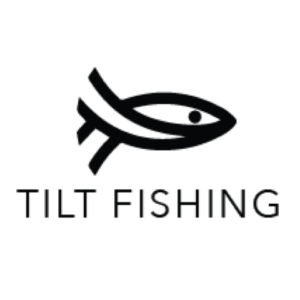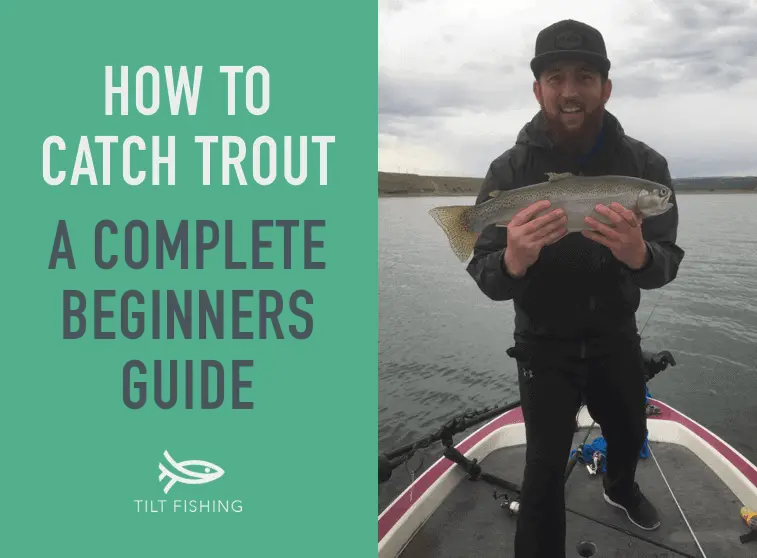Trout fishing is one of the fishing disciplines that almost has a cult following and attracts anglers from all walks of life to the cool streams where the trout live. Trout fishing evokes the image of a fisherman in waders thigh-deep in a crystal mountain stream, calmly flicking a fly rod to tempt the fish. Those who have learned how to catch trout have become hooked themselves and often become lifelong participants in the sport.
Trout fishing for beginners can be a tricky pass time that takes some time to master but offers great rewards. Trout fishing requires knowledge of some basic principles, methods, and gear, where to fish, seasons and times to fish, and some specialist knowledge that is unique to trout fishing.
This image is of the accomplished trout angler who has put in the dedication and time to get to this point where it is a relaxing and rewarding fishing experience. For many novice trout fishermen, this image of calmness is the antithesis of their experience. How to fish for trout is the focus of this article and will give the new trout fisherman a good foundation for starting in this relaxing, rewarding and addictive fishing form.
Step 1: Understand Trout Fishing Basics
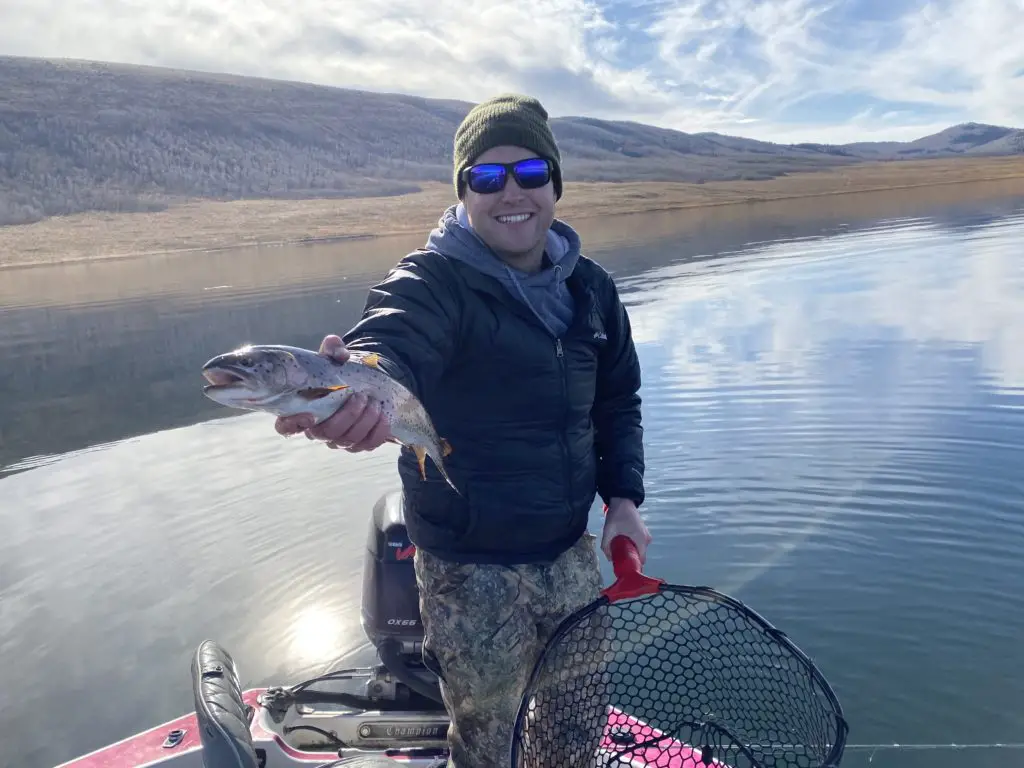
Trout fishing for beginners needs to include some information about your quarry, the trout itself. You will only become a good trout angler if you understand the fish you are going after, what their characteristics are, what their habits are, and what they like to eat.
All trout are freshwater species of fish that are closely related to salmon and char. Most trout are found in freshwater lakes, rivers, and streams, with the exception of the steelhead trout, which is a sub-species of the rainbow trout.
The steelhead trout spends two to three years out at sea before it returns to freshwater systems to spawn. This is a habit that is more often seen in the salmon species than trout.
Species Of Trout
The common name “trout” actually covers species that are recorded in three different families of fish that include hundreds of subspecies. We will cover the more popular sport and panfish species that offer the best trout fishing for beginners.
There are several factors that you may want to consider before you decide which species of trout you want to fish. The first is whether you will be fishing for the pot, the second is whether you will be fishing for the sport, and the third option is if you want to fish for both.
Brown Trout
Brown trout is a species that is native to Europe but was introduced to the US in 1883. It is a species that prefers cold water and is a popular sport fish.
Physical Appearance: Brown trout are generally olive-green to brown on the dorsal part of their bodies, which fades to a golden yellow on the flanks and fading further to an off-white belly. These fish have the characteristic trout spots on their sides and near the dorsal fin, which are black in color. These dark spots are normally highlighted by a light halo around each spot. The spots along the lateral line are normally reddish in color.
The brown trout differs from most other trout species in that the tail is generally free of spots.
Habitat: The brown trout can be found in cold-water mountain streams, larger rivers as well as ponds and lakes. It is found in 45 states in the US, making it a common angling trout across the bulk of the US.
Diet: Brown trout feed on both aquatic and terrestrial insects and the larger, adult brown trout will also eat smaller fish.
Angling Difficulty: The brown trout is considered to be a difficult species to fish because it is nocturnal, so it has to be enticed to take the bait during the day. Fly fishermen consider this fish to be a particular challenge since if you catch a brown, you know your fly was good as well as your fishing technique.
Pan Suitability: Brown trout has a strong flavor and is generally an acquired taste. It does make for good eating, but some people love it, and others hate the flavor. You will have to try it to determine if this will be a pan-species for you or a catch and release.
Rainbow Trout
The rainbow trout is probably the most well-known of all the trout and is the first species that comes to mind for most people when trout are mentioned.
The rainbow trout is a species that is native to the US, originally in the western states but has been introduced to the majority of the other states. This makes it a fish that is available to most trout fishermen anywhere across North America.
Physical Appearance: These colorful fish have a range of iridescent colors on their bodies that vary with gender, age, and location. However, they all have a punk band that runs the length of their bodies and have a silvery belly that fades to a pearl-white. They have relatively small black spots on their backs and fins and also on their tails.
Habitat: Rainbow trout prefer cool mountain streams with gravel beds with boulders and fallen trees to provide natural cover. They prefer water that is in the temperature range of 55F to 60F but can adapt to waters that are as low as 32F and as warm as 70F. These fish are sensitive to habitat changes and habitat destruction, which has led to declining numbers in some areas. They are found mostly in the western states of the US, the central states, and the mid-eastern states.
Due to the high popularity of rainbow trout as a sport fish, however, they are often farmed in ponds in other states across the US for fishing purposes.
Diet: These fish are opportunistic feeders, eating anything from insects to crustaceans, worms, other small fish, and fish eggs. They will regularly raid other fish breeding grounds to feast on the eggs.
Angling Difficulty: Rainbow trout are considered to be an easy trout to catch. Their varied diet makes them willing to take many different bait types, which makes it easier for the angler to choose a lure for rainbow trout.
Pan Suitability: Rainbow trout are considered to be one of the best trout for eating. They can be cooked in many different ways, including smoking, grilling, baking, steaming, and pan-frying. They offer many health benefits over eating other types of fish. They are a tender fish with a slightly flaky texture that lacks a strong fishy taste.
Brook Trout
This trout is native to the eastern parts of the US and is known by many colloquial names such as brookie, speckled trout, square tail, and spotted trout. This trout is very sensitive to changes in habitat and water quality, and their numbers in a body of water will be an indicator of the quality of the water and the environment.
Physical Appearance: The Brook trout is dark green to brown with a light marble pattern that extends to the dorsal fin and sometimes all the way to the tail. The is a dispersed pattern of red spots surrounded by a blue halo down the sides of this trout. The lower fins and the belly have a reddish color. These lower fins have a white leading edge.
Habitat: Brook trout can be found in both small and large lakes, rivers, streams, and the clear water ponds of springs. They prefer areas that are protected from strong currents and will therefore congregate around boulders and fallen logs. They are very sensitive to oxygen levels in the water, pollution, and acid levels. Warm temperatures stress the fish out.
Diet: Brook trout eat aquatic insects, terrestrial insects, frogs, crustaceans, snails, other small fish, and surprisingly even some small mammals.
Angling Difficulty: Brook trout are not difficult to catch due to their varied diet and will therefore take almost any type of lure.What makes this fish a challenge to catch is the weather conditions and seasons of food availability. They are particularly active and more likely to take the bait in seasons when insects hatch out and in overcast, unpleasant weather conditions. A warm sunny day is not ideal for fishing for brookies, but it can be done if you pick your spot right. This fish is also mostly active at dawn and at dusk.
Pan Suitability: Brook trout are good to eat, but they have a stronger fish flavor than the rainbow trout, which puts some people off. If you do not like fish with a strong fishy taste, then this species is probably a good candidate for catch and release.
Cutthroat Trout
The Cutthroat trout is a native inhabitant of the western US but has also been introduced to the southeast of the US and can readily be found below federal water projects in this region. They are a popular sport fish, especially among fly fishermen.
Physical Appearance: TheCutthroat trout generally has a heavily spotted dorsal and tail fin. The sides and back of this trout are only lightly spotted. The distinguishing marking that gives them their name is a bright red marking along the bottom of both sides of the bottom jaw.
Habitat: The Cutthroat trout prefer cold water streams that have flows that fluctuate naturally. They like a habitat with a little fine sediment at the bottom and stream banks that have a lot of vegetation. They like to have lots of cover in the areas that they populate, such as rocks with overhangs or holes and fallen trees and logs.
Diet: This trout feeds on zooplankton, all riverside insects and aquatic insects, and small fish. They are particularly partial to mayflies, caddisflies, and stoneflies in the larval and pupal stages of development. In areas where small baitfish are plentiful, many adult Cutthroat trout will feed exclusively on this food source.
Angling Difficulty: Cutthroat trout are easy to catch because of their varied diet. They are particular favorites of fly fishermen due to their partiality for insects and their larvae.
Pan Suitability: The Cutthroat trout is good to eat and is considered as one of the better trout to eat next to the rainbow trout. It does have a slightly stronger fishy taste than most other panfish, so some people do not care for the taste. This trout can be filleted and pan-fried, or it can be baked whole. They can also be smoked, which is the way some people prefer to eat this fish.
Step 2: Choose A Trout Fishing Method
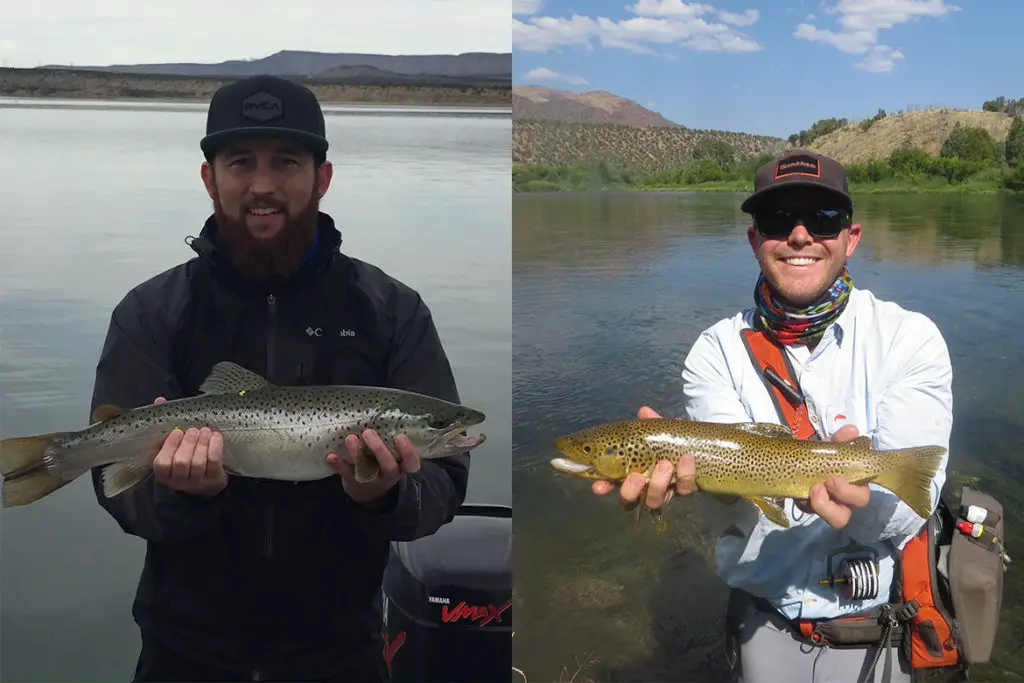
There are a number of varying methods you can use to catch trout, and each one has advantages and disadvantages. As a beginner learning how to catch trout, you can investigate each of these methods and choose one that is most suitable for the fish in your area, your personal preference, or the one that is best for the type of fishing waters near you.
- Bait fishing for trout. Bait fishing is where you incorporate the use of live bait or natural bait. The bait can include the following: worms such as nightcrawlers, normal earthworms, and red wrigglers. Crickets and grasshoppers make good live bait. Baitfish such as fatheads or any other type of minnow is good year-round bait for trout. Crayfish and aquatic insect nymphs and larvae are also good live bait options. Live bait fishing is good for high water conditions such as after rains where the water may be muddy or dirty, making it difficult for the fish to see surface lures such as flies. The smell of the fresh bait will draw them in.
- Spinning for trout. Spinners are artificial lures that have a small oval-shaped, shiny metal disc that spins as the lure is pulled through the water. The spinning flashing piece of metal is what attracts the trout due to its predatory nature. Spinners for trout are often called inline spinners due to their design. Spinner fishing is one of the easiest trout fishing methods since the technique is simply cast out and retrieve. Spinners come in a large variety of different sizes and colors, making them a very versatile lure. They can also be fished using a brass rod and a top-mounted bass bait-caster reel, which is generally cheaper than most other trout fishing rigs.
- Fly fishing for trout. Fly fishing uses an artificial lure that mimics aquatic or terrestrial insects or larvae. The flies used can be intricate and designed for specific waters. Fly tying is a hobby in itself and may fly fishermen pride themselves in creating and tying their own flies. Fly fishing requires a special, lightweight, very flexible rod and a special reel. This type of rig can get expensive, so if you are a beginner, seek out some expert advice on the gear. The technique for fly fishing is one that requires a lot of practice and can be difficult to master. It helps to have an experienced fly fisherman to mentor you to show you the ropes to get started.
- Trolling for trout. This method of trout fishing involves the use of a boat and a combination of the other fishing methods. The rod is rigged with the chosen bait, which could be live bait, a spinner, or a combination such as a worm hooked onto a spinner. Live baitfish are often a favored bait choice for trolling. The bait is cast into the water behind the boat, and the boat is slowly moved forward, dragging the bait behind it. The driver of the boat needs to move the boat forward slowly and vary the direction to mimic the erratic behavior of a prey animal. This type of fishing is used mostly in large lakes to cover a lot of water and to fish deeper in the water column. The disadvantage of this type of fishing is the cost of the boat, motor, and fuel. In some places, you may also have to qualify with a skipper’s license in order to drive a motorized boat.
Step 3: Get the Right Tackle & Gear
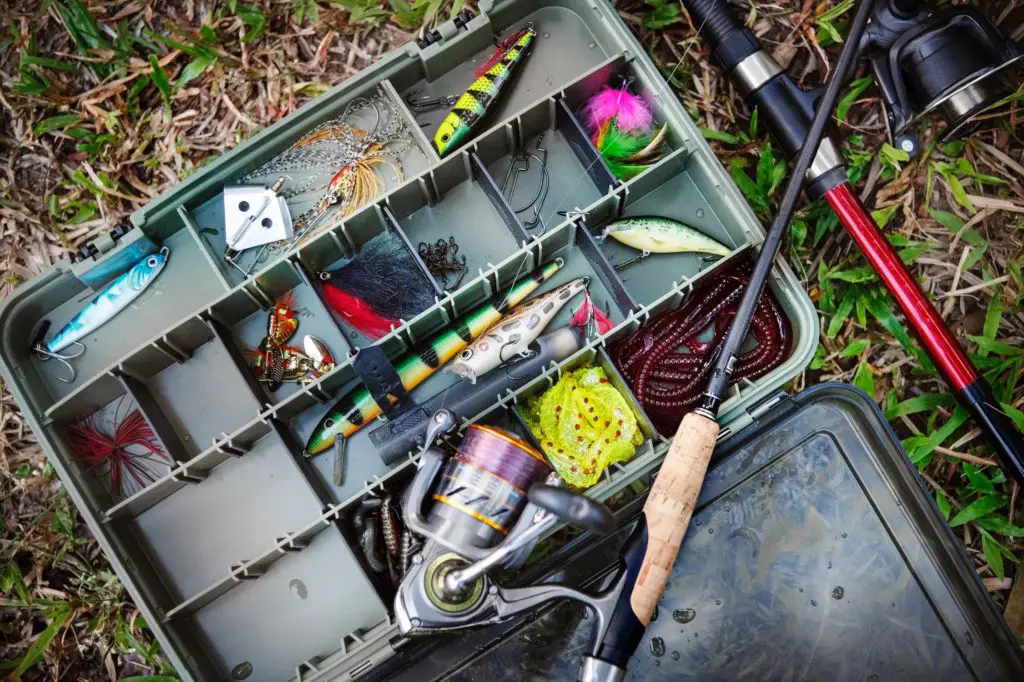
The gear that your need for trout fishing will depend on the method of fishing that you want to try out, but as a beginner, you may want to start small and with one of the easier methods before you tackle one of the more complex methods that require expensive gear.
Bait Fishing Gear For Trout
Bait fishing for trout requires fairly basic gear to get started and one of the easier ways to learn how to fish for trout.
You can use a basic bass fishing rig for this method, such as a small bass rod with a bait-caster reel or spincast reel, or a traditional style fishing rod with an underslung spinning reel, which is the most common rig. You may even have a rod and spinner reel kicking around in the basement of your house that belonged to your dad or grandad.
Besides the rod and reel, you need some line, and a 2 pound to 4-pound monofilament line is best for bait fishing trout. You can use up to a 6-pound line, but this will limit the distance that you will be able to cast.
The next thing is the bait, which you can either catch yourself at the water’s edge or purchase from a local bait shop. The local bait shop is always a good place to start since they will be able to give you good advice on what the fish are biting at that particular time of year.
You will need an assortment of hooks, floats, and weights to hook your live bait to and, of course, to hook the fish. Where possible, if you intend to catch and release, use barbless hooks, which cause less damage when removing them from the fish.
Spinning Gear For Trout
Spinning is a great method for learning trout fishing for beginners. The gear that is required is, like bait fishing, fairly basic.
You will need a basic fishing rod and reel, which can be a basic bass setup or the traditional rod with a spinner reel as well. The line should be monofilament with a breaking strain of between 2 and 6 pounds, depending on the size of trout you expect to catch.
You will also need a range of inline spinners. These can often be purchased in a set of different sizes, shapes, and colors or as individual items. It is best to get a range of sizes and colors so that you can change things up when you get to the fishing spot and have a chance to evaluate the fishing conditions.
Fly Fishing Gear For Trout
When it comes to gear, fly fishing is where things can get pricey and complicated. Fly fishing rods are highly specialized due to the techniques used in this fishing method. The rods need to be very flexible and whippy to be able to execute the casting and fly manipulation techniques correctly.
For this reason, many fly fishing rods are made out of expensive carbon fiber or composite materials, which carry a higher price tag.
The fly fishing reels can be fairly basic, but they are also relatively expensive due to the material they are made from. Generally, fly fishing reels are very lightweight to avoid fatigue due to the amount of casting and rod manipulation required for this method.
The line that is used in fly fishing is usually a very light line and sometimes braided line for a light line with additional strength.
You will need a range of flies to go with your rod and reel. These can be fairly expensive, depending on their quality and whether they were handmade or not. You will need a variety and normally a specific type of fly that mimics the normal prey for the trout in that region.
Fly fishing is normally done while standing in the water, and trout like cold water. You will need to get yourself a pair of good waders that will allow you to walk into the water and not get your feet and trousers wet.
Trolling Gear For Trout
Trolling for trout is a method that generally does not use flies or a fly fishing rod. Any of the fishing rigs mentioned for how to catch trout using the bait or spinner methods can be used for trolling.
The bait used for trolling can also be live bait or spinners; the choice will be up to you. The biggest item for this method and the most expensive will be the boat. The size of the boat will depend on the size of the body of water that you are fishing and the amount of water you intend to cover on your trip.
The larger the body of water, the larger the boat and motor you will need. Many trolling fishermen will have a separate electric motor for trolling that operates more silently than a gasoline-driven motor.
Step 4: Decide Where to Fish for Trout
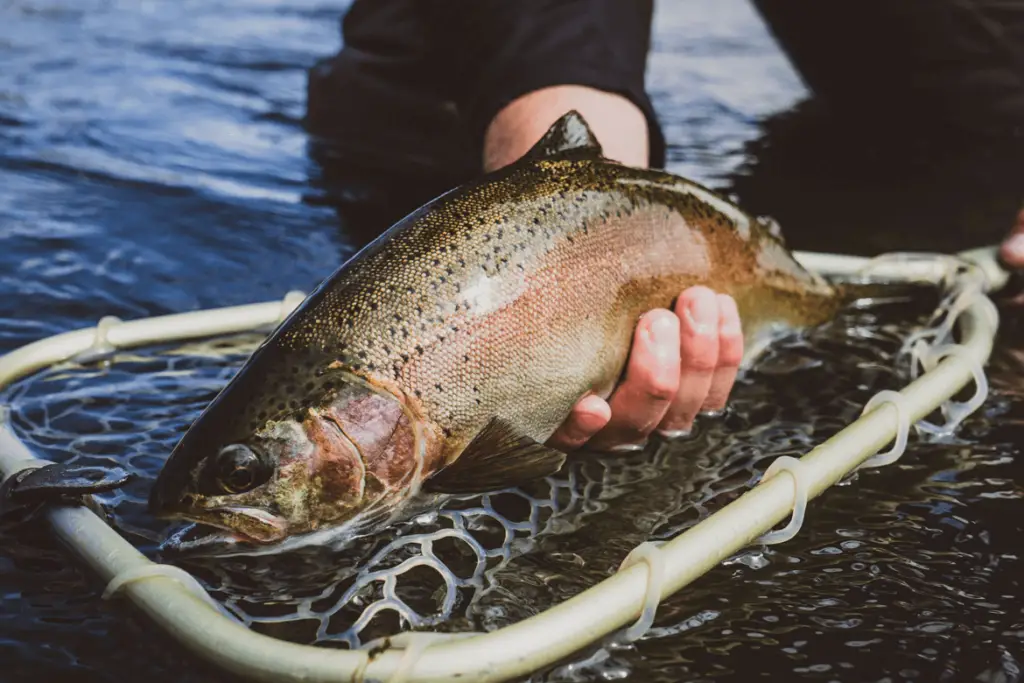
Deciding where to go trout fishing will be your next step in learning how to catch trout. Basically, your fishing location will be determined by the habitat of the trout in your area. We have compiled a list of areas where you may find trout to be and the fishing methods that are best suited to these types of locations.
- Rivers. Rivers are normally quite large bodies of water and quite fast flowing. They often carry sand and mud suspended in the water, which clouds the water and reduces visibility. Rivers can be clear, but at times of high rainfall, they can become dirty, which would require a change in fishing method. Fishing for trout in a river can be done by using the bait fishing method, the spinner method, the fly fishing method, and even trolling if the river is big enough. If the water is muddy, fly fishing and spinner fishing, and trolling with lures may be out of the question. In this instance, live bait would most likely be the better fishing method choice.
- Streams. Streams are normally smaller bodies of water at higher elevations, and they are conducive to using bait fishing and fly fishing. If the stream is large enough, you may be able to use spinners for fishing, but you may not have much distance to cast and reel in.
- Lakes. Due to lakes being larger bodies of water, they cater to all the trout fishing methods. You can bait fish, spinner fish, or fly fish from the bank, or you can do any of these from a boat as well. Trolling will allow you to fish deeper for larger fish and cover a larger area in a short amount of time.
- Ponds. Ponds being small bodies of water, do not lend themselves to trolling, but any of the other fishing methods used from the bank or from a small boat can prove to be effective in this type of environment.
Step 5: Choose When to Fish
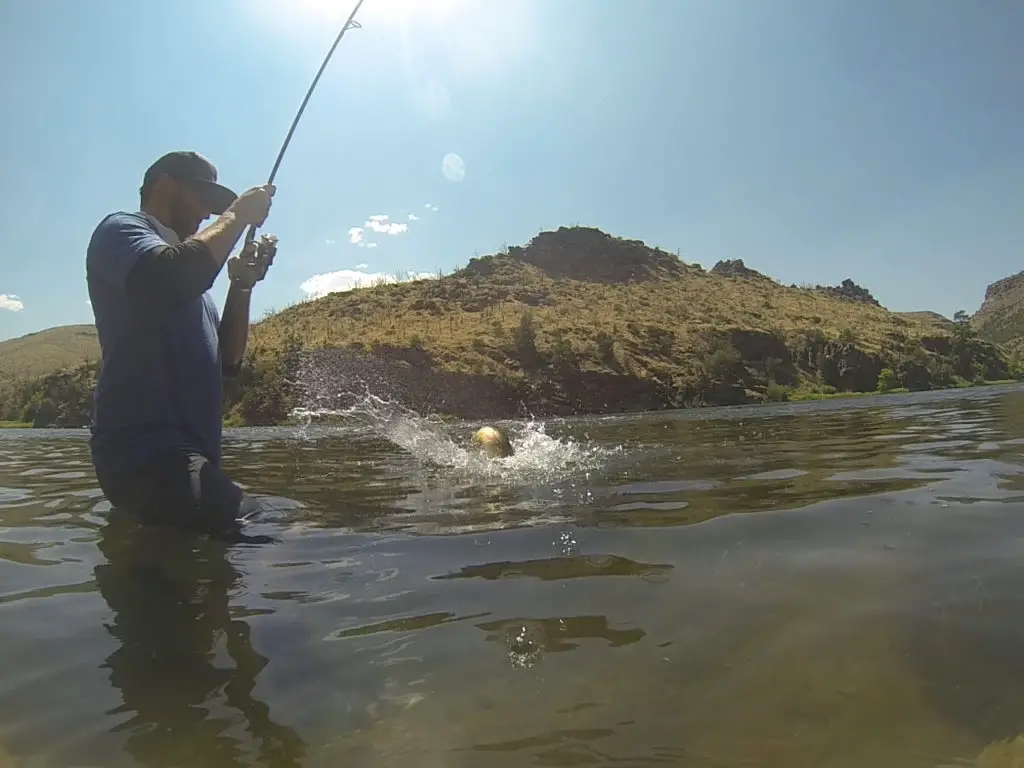
Choosing the best time to fish is as important as choosing the right gear and method to fish for trout. You need to know what trout are found in the waters you are fishing so that you can establish what the best season is to fish for them, the right bait to use in that season and even the best time of day to fish for trout.
Best Times To Fish For Trout
The best time of day to fish for trout is when the trout are feeding. This can vary from species to species and location to location.
As a rule of thumb, on a warm day, the best time to fish is early morning till about 10am and from dusk till dark. If there is a moon, you may have success fishing into the night. If the day is colder, you would have better luck if you start fishing in the afternoon from about 1pm and fish till dark. This is to give the water enough time to warm up slightly to improve the appetite of the trout.
However, you can fish at any time of day for trout if you look for the right spot. Shady spots on a river with overhanging trees would be an example of a spot where you could catch trout all day long. Take a look at another article that is dedicated to the best time to go fishing for trout.
Trout Fishing by Season
There are local rules and regulations in most places about which seasons you are allowed to catch trout. In some areas, you can catch trout all year round, but in the off-season, there may be additional rules such as only being allowed to use artificial lures and catch and release fishing only.
The easiest way to learn about the fishing laws where you want to fish is to contact the local fishing or national park authorities to find out about the rules and regulations for that time of year.
- Trout fishing in spring. Springtime is when many insect species start hatching out in preparation for their summer breeding cycles. This makes for an abundance of food for the trout, and as a result, they become more active and eager to feed. This makes it an especially ideal time for fly fishermen, but bait fishing and spinner fishing will also give good results.
- Fishing for trout in summer. The success you will have in the summertime will depend on your location. Trout generally do not like heat and will seek out shaded, cooler parts of the water when it gets hot. In lakes and ponds, this means that the fish will go deeper and will be less likely to fee on surface baits like flies. Live bait and spinner may have better success. Also, fishing in the early morning and late afternoon in the summertime will give better results.
- Fall trout fishing. Trout will be looking for some opportunistic meals in the fall in order to build up some fat reserves for the winter. The natural insect prey at this time of year will probably all but disappeared, so you may not be able to get the fish to bite easily on artificial flies unless you match them to the insect prey that is prevalent at that time of year. Terrestrial insects would make good live bait at this time of year, as would baitfish, which provide a more substantial meal and more nutritional value for the effort. Areas with stronger currents, riffles, and eddies will have higher oxygen levels and will be where you will find the most active trout.
- Trout fishing in winter. Trout will feed in winter, especially if the water temperature climbs above 40F, so watching the water temperatures would be a key strategy. If the temperature is below 40F, you will be lucky to find any trout that would be tempted to feed. So look for the warmer parts of the water where the sun catches a certain section, or there are high banks to concentrate the heat, and you may stand a better chance. The trick, however, will be to find the trout. They will not be everywhere in the body of water but will cluster in certain areas. This will be where the knowledge of a local fisherman would be very useful.
Step 6: Select a Bait, Lure, Or Fly
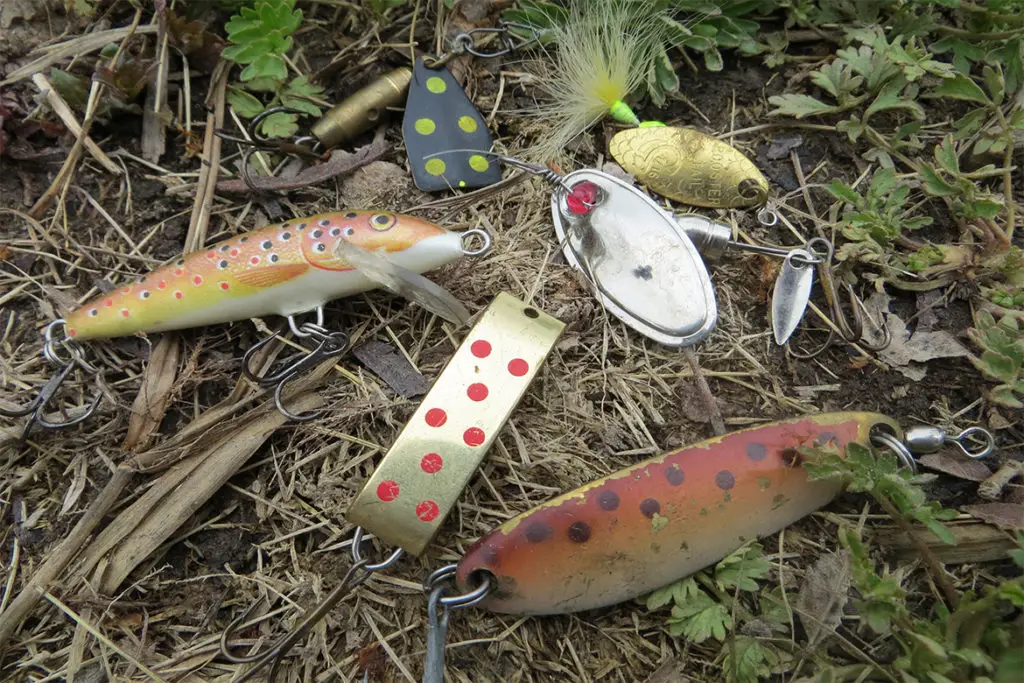
In this step in learning how to fish for trout, you can decide on the bait type that you think would best suit you and the way that you want to fish. Essentially, the method you use will drive the type of bait that you use, but there are also possibilities of using combinations.
- Trout fishing with lures. In this category, we are talking about artificial lures. There are many lures available on the market that very closely mimic the look and movement of the natural prey of the trout, from insect larvae and pupa to lures that look just like worms, hellgrammites, crickets, grasshoppers, and even baitfish. You can practically find an artificial lure to mimic any of the natural food of the trout. The rigs that you would use to fish these lures would be very similar to those that you would use for bass fishing. The techniques that you would use to fish these lures would also be the same as for bass fishing. Some people don’t like the messy aspect of dealing with live bait and sticking a hook into a living creature. If this is you, then artificial lures would be the best trout fishing option for you. You would need to be careful about your lure selection and make sure it is appropriate for the body of water, the species of trout, and the type of year. The movement of the lure to mimic the prey would be up to you to master to entice the fish to bite. Have a read of another article of ours on the best colors for trout lures to get an idea of some of the options.
- Fishing for trout with live bait. This is the most natural method to catch trout since you are using what they would normally eat as the bait on the hook. You would still need to have some knowledge about the favorite food of the trout in the area when selecting your bait, but your local bait shop should be able to supply this information. Knowledge on how to secure the bait to the hook so that the bait can move as naturally as possible will be crucial to keeping the bait alive long enough to hook a trout. You will need to do less work to attract the trout since the movement of the live bait on the hook and the scent of the live prey will attract the fish.
- Trout fishing with flies. Fly fishing for trout is probably the cornerstone trout fishing method, and most fishermen who fish for trout will try this method out at some point. This fishing method requires much more patience, skill, and timing than the other fishing methods, but it can also be the most relaxing and rewarding of all the fishing methods. You can buy readymade flies, or you can delve into the rabbit hole of tying your own flies, which may become an even greater addiction than the fishing itself. Fly tying is considered an art form to the point of precision and technique, and creativity that goes into creating a fly for trout fishing. There is, however, nothing better than catching a trout on a fly that you tied yourself! Fly fishing is considered to be one of the most technical and difficult of the fishing types to master, and you will need to spend many hours on dry land, practicing your casts and technique with your rod and flies. But, as is generally the situation with most activities that are worth doing, there is an element of difficulty to it. Fly fishing is awesome, but you need to go into it with your eyes open and realize that it may take a while before you master the technique and actually catch your first fish!
Step 7: Tie the Right Fishing Knot
Knot tying is a skill that you are will need to add to your tackle box so that you can keep the fish you hook and keep your expensive lures and flies. There is no worse outcome for a fisherman than losing a fish because of a poorly tied knot!
There are a few basic fishing knots that everyone should learn when they learn how to catch trout. These basic knots will be a foundation that you can build on for more complicated riggings as you become more proficient.
Uni-Knot
The uni-knot is one of the most common knots used in fishing. The “uni” stands for universal because it is suitable for so many applications. It can be used to tie flies, lures, and jigs to leader lines or securing hooks to lines. This knot retains 95% of the line strength when tied correctly, making it one of the strongest knots you can use to secure your lures.
The uni-knot is, therefore, the first knot that you should learn in your quest to become a trout fisherman!
Palomar Knot
The Palomar knot is another favorite knot for the fisherman to secure the line to a hook, lure or fly. This knot is especially good for very light lines and for braided lines that you may use in fly fishing. This knot is very secure, and when tied properly, it is almost impossible to pull out accidentally and lose a fish as a result of the knot coming undone.
You need to put the Palomar knot on your list of knots to learn when learning how to catch trout.
FG-Knot
The FG-knot is one of the strongest knots that you can use to tie two lines together. It is a fairly complex knot, especially for a beginner, but it is a knot that you will constantly use throughout your fishing endeavors!
The FG-knot can be used to join monofilament lines to braided lines, leaders to lines, and monofilament to monofilament.
The FG-knot takes a little time to learn, but it will be the only knot you need to know to join lines together.
Step 8: Catching & Landing Trout
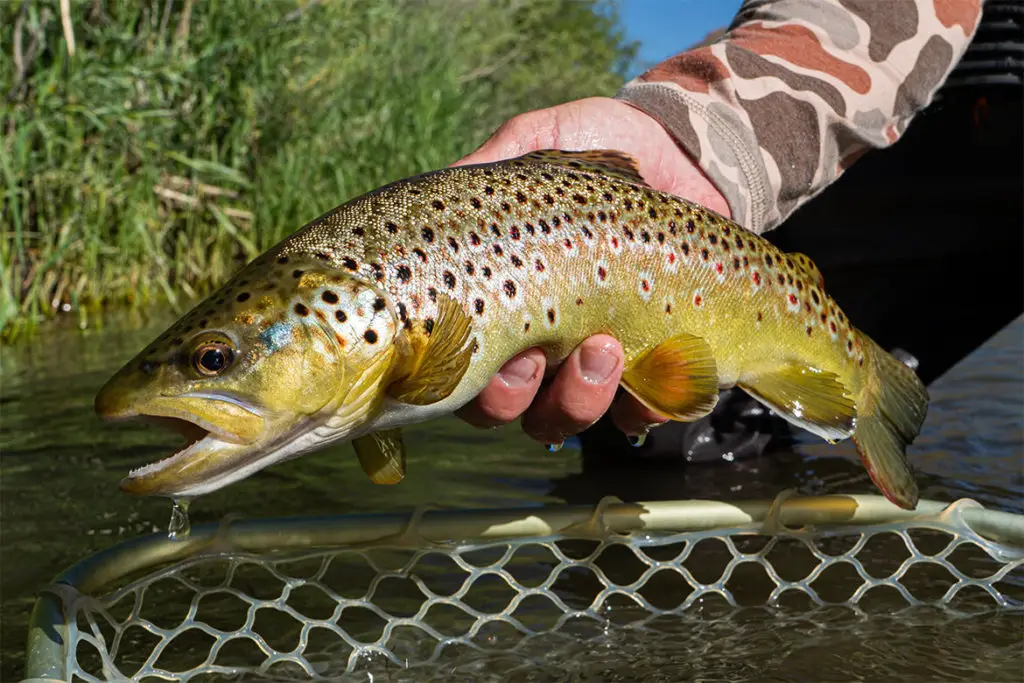
When you start learning how to catch trout, you may have all the right gear and the latest lures, but you need to arm yourself with some information on how to actually catch and land the trout.
When the fish bites, you need to strike to set the hook in the trout’s mouth in order to be able to reel it in. the techniques for striking vary depending on the type of lure you are using and are completely different if you are fly fishing. Striking with a lure usually involves sharply pulling up the tip of the rod or up and to one side to set the hook in the fish. The direction of your stroke depends on how the fish takes the lure.
Setting the hook in fly fishing is done with the hand on the line, rather than the one holding the rod. You strike with the line in the hand in the appropriate direction to set the hook and then use the rod and reel to pay the fish in.
Whatever your fishing method, lure or fly or bait, once the fish is hooked, you don’t want to simply crank the fish in with the reel. You will need to watch the fish, and depending on how active it is, you may need to let it run a little to tire it out some before finally reeling it in.
Cranking took hard on the line with an active fish on the other end is asking for a line break, which will result in a lost fish.
If you are trout fishing from a boat, you will need a net to land the fish in the boat in order to remove the hook. When fishing from the bank, once you have the fish near the bank, do not lift the fish up out of the water on the line. Rather put the rod down and lift the fish out of the water gently but firmly with both hands. You will then have the control to be able to safely remove the hook from the fish and choose to keep or release.
Care needs to be exercised when handling trout, particularly if they are to be released. The area above and just behind the pectoral fins, which are the ones just behind the gills, is very sensitive. Important organs such as the heart and other organs lie in this area, and applying too much pressure on this area with your hands can cause the fish to die.
Unless you are an experienced trout fisherman, it is recommended that you use a net to land your trout, even if you are fishing from the bank, particularly if you will be releasing the fish. The net gives you more control without damaging the fish.
Step 9: Keeping or Releasing Trout
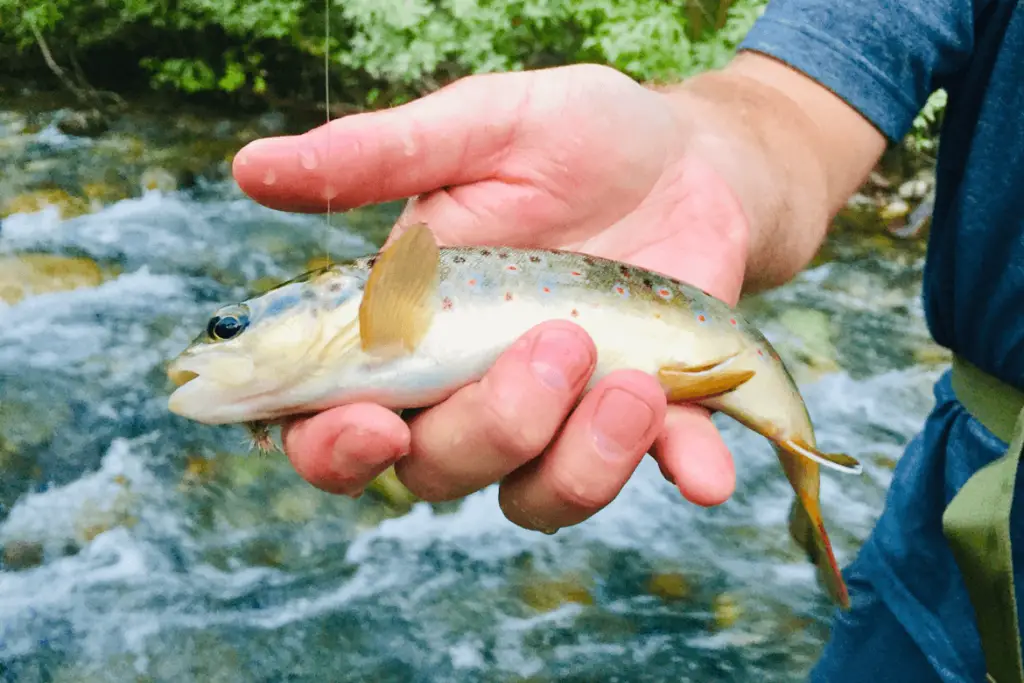
In some cases, the decision to keep r release may not be your choice. In certain seasons, the local regulations regarding trout fishing may require that you catch and release rather than catch and keep.
You will need to consult with local authorities to find out the regulations on the length of fish that you can keep and which ones must be released, and whether keeping any fish is permitted in the season that you are fishing.
In some locations, there are also restrictions as to what bait and tackle you are allowed to use in certain seasons. Some areas only allow the use of artificial lures and barbless hooks all year round, or sometimes in certain seasons.
Releasing Trout
If the trout are to be released, then you need to make sure you take every precaution to ensure the survival of the fish.
- Don’t fight the fish too hard. A tired fish at the end of a fight may be too stressed and exhausted to recover it is when released.
- Don’t fish in hot temperatures. Once water temperature gets above 70F, it holds less oxygen than when it is cooler. Trout also don’t handle heat well, so fishing in the heat with low oxygen levels in the water will stress out a fish to the point that it won’t recover after release.
- Use barbless hooks. Barbed hooks are difficult to remove from the fish without causing damage to the fish of the need to hold the fish tight while you work the hook loose. Barbless hooks come out significantly easier, causing less stress and damage to the fish. In some areas, it may be a requirement to fish with barbless hooks.
- Use a net to land the fish. Once you have reeled the fish into the shallows, the safest method of landing it is with a net. Using a net will keep the fish contained and even allow you to keep it in the water while you remove the hook.
- Don’t handle the trout too much. The skin of the trout produces a slimy protective layer that protects the skin and the fish from infection and disease. Handling the fish too much or with dry hands will rub this slimy layer off and expose the fish to disease.
Releasing a dead trout does not count as catch and release, and it is a waste of our natural resources. If you catch a fish and it dies, ethically, you need to keep it, and it counts towards your quota for the day.
Keeping Trout
In most locations, there will be a limit to the amount of trout that you can keep. Once you have reached your limit, you can continue to fish, but you must catch and release. But how do you know which fish you should keep?
If you are going to keep a fish, the usual intention is that you are going to cook and eat the fish. For this reason, the fish that you keep should be the ones that will be good to eat. The bigger, older trout may be great to fish, but they are not as good to eat. The best trout to eat are in the 10-inch to 12-inch range.
A trout over 12-inches is not going to taste so good, so it would be a good candidate for release. Any fish under 9-inches would also be a good candidate for release since it is too small to make a decent meal.
The best size range to keep, therefore, would be a fish that is between 9 and 12-inches. The other should all be released.
Trout Fishing Tips
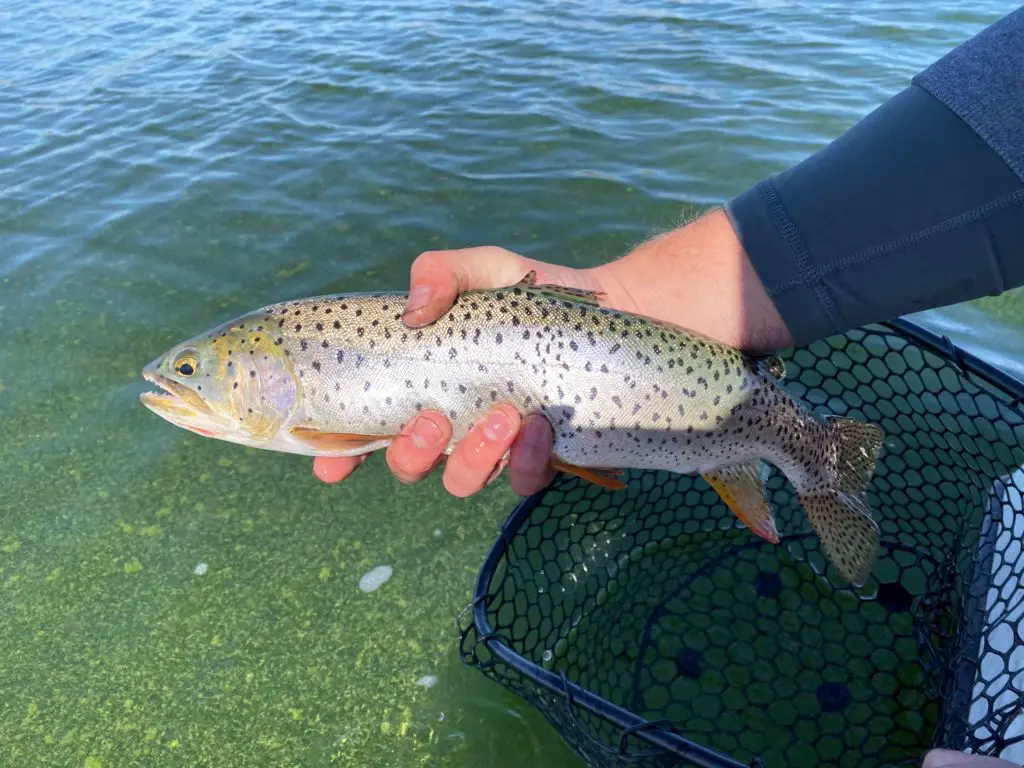
If you are a beginner trout fisherman, it is worth getting as much input from seasoned trout fishermen as you can.
One of the best ways to get the advantage of this kind of expertise is to go on a trout fishing trip where you get accompanied by a guide. The guide can help you to find good fishing spots, show you what habitats to look for and help you with lure selection, and give you tips on fishing techniques.
Alternatively, going on a trip with an experienced buddy can also jumpstart your knowledge and training towards becoming an accomplished trout fisherman.
If you are searching for some great trout fishing trips, you can try these locations where you can gain experience by catching more trout!
- Montana. Montana offers great trout fishing potential, especially around Ennis. The remote location offers pristine waters and excellent fishing opportunities.
- Arkansas. This state has some of the best trout fishing waters in the country. The White River in this state boasts abundant trout populations, a mild climate, and beautiful scenery.
- Iowa. The northeast region of Iowa offers many small streams and tributaries where fishing with spinners will give you great results.
- North Carolina. This state offers many great fishing spots in the foothills of the Appalachian mountains, and the Great Smoky Mountain national park, and the two national forests Nantahala and Pisgah offer superb fly fishing opportunities.
- Wyoming. The North Platte River and the Yellowstone National Park offer some great destinations for catching large fish.
- Idaho. This state offers all year round trout fishing opportunities, but the best time is spring. Henry’s Fork is a popular location among trout fishermen.
- Utah. Another great springtime trout fishing location is the Green River in Utah, which is well-known for large rainbow and brown trout. There are a number of great trout fishing spots in Utah, including Silver Creek, Boise River, and the St. Joe River.
Final Thoughts
Trout fishing is one of the most popular forms of fishing because trout are exciting and challenging fish to catch and also good to eat.
Most fishermen who fish trout will also fish other types of game fish, but trout will be a special quarry to go after that many will call the best fishing of their lives.
Fishing for trout requires a love of the outdoors and nature and an ethical mindset that cares for the state of the natural environment and everything that lives in it, including the trout.
Fish responsibly, fish ethically, and stay within the rules, and trout fishing can be a rewarding, exhilarating, relaxing, stress-relieving activity that will get you outdoors enjoying a healthier lifestyle.
If you are contemplating fishing for trout, I can highly recommend it, and you needn’t think twice about taking it up. But a word of warning should be heeded, once you start, you may not be able to stop, and it may become the focus of all your holiday planning and what you think about most when you have the opportunity for a weekend away!
